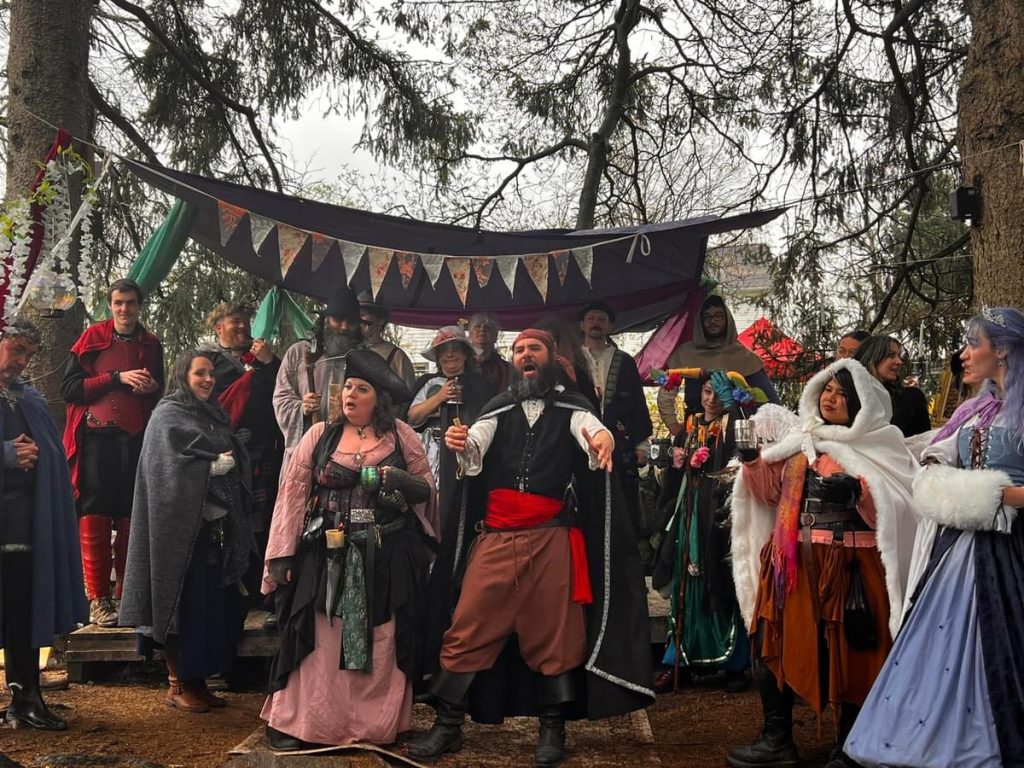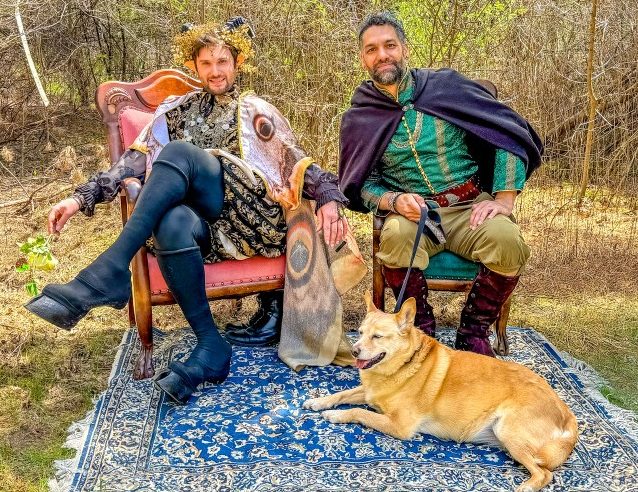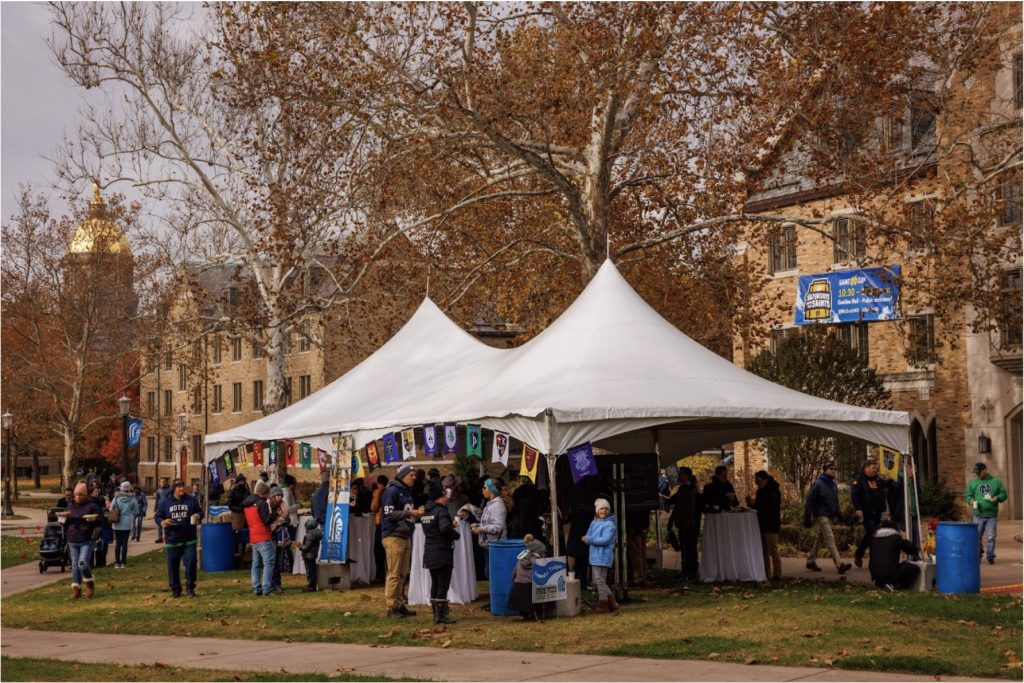I am always looking for my next adventure, and so this past year I took a risk and wandered into new territory. Through creative partnership with my wife, Rajuli Fahey, and the many folks involved in what became FaeGuild Wonders, we together built not one but two inaugural Renaissances Faires in Massachusetts. Rajuli served as Art & Entertainment Director, and Stage Manager (and one of the Vending Coordinators at the latter faire), I served as Creative & Theatrical Director, Playwright and Academic Consultant for both Wyndonshire Renaissance Faire at the Community Park in our resident town of Winchendon, MA and Enchanted Orchard Renaissance Faire at Red Apple Farm just down the road in nearby Phillipston, MA.

Public medievalism has long been a professional interest and personal passion of mine, and although I enjoy scholarship and traditional ways of academically engaging with medieval history, literature and culture, I am also drawn to the fantastic and wondrous, to the creative and adaptive, and it has long been a personal dream to produce full-scale Renaissance Faire that takes medieval literature and the aesthetic of wonder as its creative direction. Indeed, during my PhD studies at the University of Notre Dame, I organized a small-scale theatrical production called Grendelkin, which featured innovative and avant-garde performances related to Beowulf, which brought together musical artists, professional dancers and early medieval English scholars.

The project’s scope expanded well beyond anything I might have anticipated when I signed on to be a Member of a Planning Group in our small Town of Winchendon, agreeing to create characters and produce a script, storyline and lore for Park & Recreation Member Dawn Higgins’ RenFaire initiative. Of course, there were many challenges to overcome along the way, some from the nature of startup projects and some from the circumstances surrounding organizing two distinct faires with very different models and storylines, which debuted back-to-back weekends this spring. While my blog today is in part a celebration of both events, it will center primarily on the creative inspiration and direction that shape both Renfaires and the world-building aspects that allowed me to leverage my expertise and love of medieval literature, especially that which contains monstrous and wondrous elements, in my creative process.

However, before we dive too deep into the creative process, a brief description of both faires is in order:
Wyndonshire Renaissance Faire
For this faire, Rajuli and I both volunteered our professional services in order to support our town, local community and the beautiful amphitheater at the Winchendon Community Park. As the project grew so did our roles in the production of Wyndonshire. What began as a modest endeavor bloomed into a full-blown production that welcomed and engaged the local art community. Although all of the characters are fictitious (some cocreated with the character actors themselves), I based the House names around prominent families from Winchendon (the Murdocks and Whitneys in particular), though there is no intended relationship (allegorical or otherwise) between the Wyndonshire nobles and said historical families. This year’s plotline centered around “The Wyndonshire Wedding” between the Blue Princess (played by Melony “Melegie” Lemony) and Green Prince (played by Drew Dias). The wedding is coupled with political intrigue and subterfuge, resulting in a contest for power between the Blue King (played by James Higgins), Green Queen (played by Tammy Dykstra) and Red Baron (played by Dave Fournier) and culminating in a peasant revolt featuring rogues, pirates and marauders led by the Robber Baroness (played by Micayla Sullivan), the Pirate Queen (played by Katharine Taylor) and the Viking Jarl (played by Jason Sumrall).

Enchanted Orchard Renaissance Faire
After Wyndonshire was underway, this faire was conceived in collaboration with a local farm and festival venue, Red Apple Farm, owned by Al and Nancy Rose, who were excited to cocreate an event such as this in order to advertise their growing business, provide interactive and experience-based agricultural awareness, bring tourism to the surrounding area and support both the regional economy and artist community. Enchanted Orchard Renaissance Faire features fictitious characters and storylines that are centered on sustainable farming practices and agrarian life which was the bedrock for the medieval world. The main conflict concerns a disagreement between the nobles as to whether or not to expand the orchard or preserve the forest, with the Orchard King (played by Paul Taft) and Blossom Baroness (played by Jen Knight) advocating for conservation and the May Queen (played by Tammy Dykstra) and Duke of Thorns (played by Dave Fournier) opposing and advocating for preservation, ending with an unexpected marriage proposal and announcement between the Prince of Leaves (Michael Barboza-McLean) and the Blueberry Princess (Melanie “Melegie” Lemony).

These events included performances by musical and theatrical groups such as The Knights of Lord Talbot, Meraki Caravan, The Phoenix Swords, The Shank Painters, The Harlot Queens, The Warlock Wondershow, The Misfits of Avalon, Diva Di, Dead Gods are the New Gods, The Green Sash, The Mt. Wichusett Witches, Skeleton Crew Theater, Massachusetts Historical Swordsmanship [HEMA], The Ditrani Brothers, Nagashri Dancers, PsyBEL, Our Dance Space and numerous solo performers.
Obviously, RenFaires are at their core fantasy. They do not reflect in any consistent or credible way the historical realities of the medieval or early modern period, and even those groups and projects that are purportedly more focused and committed to historical accuracy, such as the Society for Creative Anachronism [SCA] and Pennsic Wars, acknowledge the deep limitations of attempting to recreate a historical past in the present: it’s simply not possible.

Although folk certainly do not (and cannot despite best efforts) actually travel back in time when attending a RenFaire, and many of the performance groups embed non-historical or fantastic elements, the desire to experience something historically adjacent, something medievalish, to invoke modern perceptions (and at times misconceptions) of premodern times, and to be immersed in a world of medievalism, has bloomed in recent years and will likely continue to grow. As a medievalist interested in the intersection between medieval studies and medievalism, my goal in cocreating and directing these RenFaires was never to recreate the historical past or attempt to conjure the authentic premodern world, but rather to evoke the experience and aesthetic of wonder that imbues so many of the works of medieval literature I love most and which dramatize the monstrous, the magical, the mysterious, miraculous and the uncanny. I asked myself and the Muses two essential questions: 1.) what would it be like to walk into a work of medieval literature? And, 2.) what would it be like to walk into a medievalesque fantasy world?

I knew I wanted the experience to be highly immersive. I wanted folks attending to feel part of something—to have almost crossed into a fairyworld or an uncanny realm. I wanted the experience to be overwhelming, with too much to possibly see or do. I wanted to create the illusion of entering a world that is alive with everything from town gossip to its own historiography and mythography. Most of all, I wanted the patrons to experience the wonder that is embedded throughout medieval literature and that makes medievalism such a joy to modern audiences. I decided to include both stage performances and many immersive skits, as well as multiple interlacing subplots that come together at various points throughout the events.

In the end, both faires were a wicked good time and proved to be huge successes—for the town and for the farm—and from these experiences a community formed into a sort of immersive theater company, FaeGuild Wonders. Because of our unique approach to these Renaissance Faires, the immersive and theatrical dramatizations in particular, and the inclusive spirit of community present at these events, we received some local press leading up to and after their debuts. But the best part of the entire process for me, personally, was not even seeing my vision come to life—it was the community building and getting to collaborate with my friends and family.

I could talk about each event in detail, exploring the ways I engage the medieval aesthetic of wonder as well as the modern imaginary, but those will likely be the substance of future blogs on Wyndonshire and Enchanted Orchard. Most exciting of all for me to share is a brand-new event that Rajuli and I are planning and directing this winter, again in collaboration with the Red Apple Farm team led by the Roses (because they were such awesome partners): the Northfolk Nightmarket on February 22nd and 23rd 2025. This will offer me the incredible opportunity to dramatize the story of Beowulf, the subject of my dissertation and the majority of my scholarship, and interweave the story into an inaugural event which will draw inspiration directly from medieval lore, literature, myth and legend. Perhaps we’ll see you there?
Richard Fahey, PhD in English
Medieval Institute
University of Notre Dame




